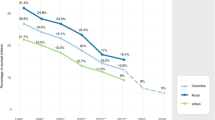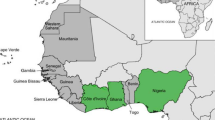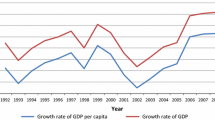Abstract
About 40%, 15%, and 38% of children in Bangladesh are stunted, wasted, and underweight, respectively. This paper explores the causal relationship between maternal employment and under-five children malnutrition in Bangladesh by using the instrumental variable approach utilizing the augmented cross-sectional samples of 25,667 and 1665 ever-married women at the national level and in metropolitan cities, respectively. This study finds a higher likelihood of stunting children of employed mothers at the national level, at 11.7%. The probabilities of stunting, wasting, and underweight children of employed mothers are also very high in metropolitan cities at 15.8%, 2.9%, and 11.6%, respectively. These impacts on the children of formal-working mothers are comparable to those of both formal and informal-working mothers, almost double at the national level and in metropolitan cities. The likelihood of stunting children of formal-working mothers at the national level is 20.2% and the probabilities of stunting, wasting, and underweight children of formal-working mothers in metropolitan cities are 28.3%, 5.3%, and 20.9%, respectively. This study is a good reference for the policymakers of Bangladesh; with it, they can adopt effective measures to curb early childhood malnutrition.

Similar content being viewed by others
Availability of data and materials
Used data of the DHSs are available in the following link: https://dhsprogram.com/data/available-datasets.cfm.
Notes
Section-45 states that working women will receive a maternity leave of 4 months (8 weeks before and 8 weeks after birth) for their first and second children. Later, this was amended by gazette notification in 2011, for 6-month maternity leave in the public sector (MoF 2011), which is also being implemented in the private sector gradually.
References
Almond D, Currie J (2011) Killing me softly: the fetal origins hypothesis. J Econ Perspect 25(3):153–172
Amarante V et al (2016) Do cash transfers improve birth outcomes? Evidence from matched vital statistics, and program and social security data. Am Econ J Econ Policy 8(2):1–43. https://doi.org/10.1257/pol.20140344
Anderson PM, Butcher KF, Levine PB (2003) Maternal employment and overweight children. J Health Econ 22(3):477–504. https://doi.org/10.1016/S0167-6296(03)00022-5
Baker M, Gruber J, Milligan K (2008) Universal child care, matemal labor supply, and family well-being. J Polit Econ 116(4):709–745. https://doi.org/10.1086/591908
BBS (2020) Statistical yearbook Bangladesh 2019. Bangladesh Bureau of Statistics, Statistical Division, Ministry of Planning Government of the People’s Republic of Bangladesh, Dhaka
Becker GS (1965) A theory of the allocation of time. Econ J 75:493–517
Bianchi SM (2000) Maternal employment and time with children: dramatic change or surprising continuity? Demography 37(4):401–414. https://doi.org/10.1353/dem.2000.0001
Biddle BJ (1986) Recent development in role theory. Ann Rev Sociol 12:67–92
Bishop J (2011) The effect of maternal employment on youth overweight in Australia. Econ Rec 87(SUPPL. 1):92–104. https://doi.org/10.1111/j.1475-4932.2011.00747.x
Black SE, Paul JD, Kjell GS (2007) From the cradle to the labor market? The effect of birthweight on adult outcomes. Q J Econ 122(1):403–439. https://doi.org/10.3386/w11796
Boserup E (1970) Woman’s role in economic development. St Martin’s Press, New York
Brewer M et al (2020) Does more free childcare help parents work more? IFS Working Paper W20/9. London. https://doi.org/10.1920/wp.ifs.2020.920
Bryce J et al (2008) Maternal and child undernutrition: effective action at national level. Lancet 371(9611):510–526. https://doi.org/10.1016/S0140-6736(07)61694-8
Case A, Angela F, Chiristina P (2005) The lasting impact of childhood health and circumstances. J Health Econ 24(2):365–389
Currie J, Moretti E (2007) Biology as destiny? Short- and long-run determinants of intergenerational transmission of birth weight. J Law Econ 25(2):231–264
Datar A, Nicosia N, Shier V (2014) Maternal work and children’s diet, activity, and obesity. Soc Sci Med 107:196–204. https://doi.org/10.1016/j.socscimed.2013.12.022
Deaton A (1997) The analysis of household surveys: a microeconometric approach to development policy. World Bank Publications, Washington, DC. https://doi.org/10.1596/0-8018-5254-4
Dewey KG, Begum K (2011) Long-term consequences of stunting in early life. Matern Child Nutr 7(SUPPL. 3):5–18. https://doi.org/10.1111/j.1740-8709.2011.00349.x
Diiro GM, Sam AG, Kraybill D (2017) Heterogeneous effects of maternal labor market participation on the nutritional status of children: Empirical evidence from rural India. Child Indic Res 10:609–632
Dustmann C, Schönberg U (2012) Expansions in maternity leave coverage and children’s long-term outcomes. Am Econ J Appl Econ 4(3):190–224. https://doi.org/10.1257/app.4.3.190
Ezzati M et al (2002) Selected major risk factors and global and regional burden of disease. Lancet 360(9343):1347–1360. https://doi.org/10.1016/s0140-6736(02)11403-6
Fakir AMS, Khan MWR (2015) Determinants of malnutrition among urban slum children in Bangladesh. Health Econ Rev 5(1):1–11. https://doi.org/10.1186/s13561-015-0059-1
FAO (2019) The state of food security and nutrition in the world 2019. FAO, Rome. https://doi.org/10.4060/CA5162EN
Glick P, Sahn DE (1998) Maternal labour supply and child nutrition in west Africa. Oxf Bull Econ Stat 60(3):325–355. https://doi.org/10.1111/1468-0084.00103
GoB (2006) Labour Act, 2006 (XLII of 2006). The People’s Republic of Bangladesh. ReMiSi Publishers, Dhaka
Haddinot J et al (2008) Effects of a nutrition intervention during early childhood on economic productivity in Guatemalan adults. Lancet 371(9610):411–416. https://doi.org/10.1016/S0140-6736(08)60205-6
Heintz J, Kabeer N, Mahmud S (2018) Cultural norms, economic incentives and women’s labour market behaviour: empirical insights from Bangladesh. Oxf Dev Stud 46(2):266–289. https://doi.org/10.1080/13600818.2017.1382464
Hjort J, Sølvsten M, Wüst M (2017) Universal investment in infants and long-run health: evidence from Denmark’s 1937 home visiting program. Am Econ J Appl Econ 9(4):78–104. https://doi.org/10.1257/app.20150087
Jakaria M, Bakshi RK, Hasan MM (2022) Is maternal employment detrimental to children’s nutritional status? Evidence from Bangladesh. Rev Dev Econ 26:85–111. https://doi.org/10.1111/rode.12819
Jia N, Dong X, Song Y (2018) Paid maternity leave and breastfeeding in urban China. Fem Econ 24(2):31–53. https://doi.org/10.1080/13545701.2017.1380309
Khan REA, Raza MA (2014) Child malnutrition in develo** economies: a case study of Bangladesh. Qual Quant 48(3):1389–1408. https://doi.org/10.1007/s11135-013-9842-4
Kim R et al (2017) Relative importance of 13 correlates of child stunting in South Asia: insights from nationally representative data from Afghanistan, Bangladesh, India, Nepal, and Pakistan. Soc Sci Med 187:144–154. https://doi.org/10.1016/j.socscimed.2017.06.017
Krafft C (2020) Why is fertility on the rise in Egypt? The role of women’s employment opportunities. J Popul Econ 33(4):1173–1218. https://doi.org/10.1007/s00148-020-00770-w
Lamontagne JF, Engle PL, Zeitlin MF (1998) Maternal employment, child care, and nutritional status of 12–18- month- old children in Managua, Nicaragua. Soc Sci Med 46(3):403–414. https://doi.org/10.1016/S0277-9536(97)00184-6
Lenze J, Klasen S (2017) Does women’s labor force participation reduce domestic violence? Evidence from Jordan. Fem Econ 23(1):1–29. https://doi.org/10.1080/13545701.2016.1211305
Leslie J (1988) Women’s work and child nutrition in the Third World. World Dev 16(11):1341–1362
Mark S et al (2012) Household income, food insecurity and nutrition in Canada youth. Can J Public Health 103(2):94–99. https://doi.org/10.1007/BF03404210
Miguel E, Kremer M (2004) Worms: identifying impacts on education and health in the presence of treatment externalities. Econometrica 72(1):159–217. https://doi.org/10.1111/j.1468-0262.2004.00481.x
Mocan N, Raschke C, Unel B (2015) The impact of mothers’ earnings on health inputs and infant health. Econ Hum Biol 19:204–223
MoF (2011) Bangladesh Gazette, Addl. No., (pp. 159). Ministry of Finance, the People’s Republic of Bangladesh. Dhaka: BG Press.
Morrill MS (2011) The effects of maternal employment on the health of school-age children. J Health Econ 30(2):240–257. https://doi.org/10.1016/j.jhealeco.2011.01.001
NIPORT and ICF International (2015) Bangladesh Demographic and Health Survey 2014. National Institute of Population Research and Training - NIPORT/ICF, Dhaka. https://dhsprogram.com/pubs/pdf/FR311/FR311.pdf
Oppong C (1983) Women’s roles, opportunity costs, and fertility. Academic Press, New York
Pandey A (2007) Status in the family and nutritional status of their under five children. Raipur. https://doi.org/10.9790/1959-0504030811
Parker SW, Todd PE (2017) Conditional cash transfers: the case of progresa/oportunidades. J Econ Lit 55(3):866–915. https://doi.org/10.1257/jel.20151233
Pelletier DL (1994) The relationship between child anthropometry and mortality in develo** countries: implications for policy, programs and future research. J Nutr 124(10 Suppl):2047S-2081S. https://doi.org/10.1093/jn/124.suppl_10.2047S
Pulok MH, Sabah MNU, Enemark U (2016) Socioeconomic inequalities of child malnutrition in Bangladesh. Int J Soc Econ 43(12):1439–1459. https://doi.org/10.1108/IJSE-03-2015-0065
Rahman and Islam (2013) Female labour force participation in Bangladesh: trends, drivers and barriers. ILO Asia-Pacific Working Paper. https://www.ilo.org/newdelhi/whatwedo/publications/WCMS_250112/lang--en/index.htm
Rashad AS, Sharaf MF (2019) Does maternal employment affect child nutrition status? New evidence from Egypt. Oxf Dev Stud 47(1):48–62. https://doi.org/10.1080/13600818.2018.1497589
Rastogi S, Dwivedi LK (2014) Child nutritional status in metropolitan cities of India: does maternal employment matter? Soc Change 44(3):355–370. https://doi.org/10.1177/0049085714536799
Rice AL et al (2000) Malnutrition as an underlying cause of childhood deaths associated with infectious diseases in develo** countries. Bull World Health Organ 78(10):1207–1221
Short SE, Chen F, Entwisle B, Fengying Z (2002) Maternal work and child care in China: a multi-method analysis. Popul Dev Rev 28(1):31–57. https://doi.org/10.1111/j.1728-4457.2002.00031.x
Stock JH, Yogo M (2005) Testing for weak instruments in linear Iv regression.” In identification and inference for econometric models: essays in honor of Thomas Rothenberg, ed. D. W. K. Andrews and J. H. Stock, 80–108. Cambridge: Cambridge University Press. Strauss, John, and Du. J Econ Lit 36(2):766–817
Tanaka T, Takahashi K, Otsuka K (2020) Increasing female education, stagnating female labor force participation, and gains from marriage: the case of rural Bangladesh. https://www.cabdirect.org/cabdirect/abstract/20203182368
Tucker K, Sanjur D (1988) Maternal employment and child nutrition in Panama. Soc Sci Med 26(6):605–612. https://doi.org/10.1016/0277-9536(88)90024-X
Ukwuani FA, Suchindran CM (2003) Implications of women’s work for child nutritional status in sub-Saharan Africa: a case study of Nigeria. Soc Sci Med 56(10):2109–2121. https://doi.org/10.1016/S0277-9536(02)00205-8
Ulijaszek SJ, Leighton D (1998) Maternal employment and child nutritional status in a very poor population of residents and migrants from Bangladesh in Calcutta, India. Anthropol Sci 106(3):253–263
Van De Poel E et al (2007) Malnutrition and the disproportional burden on the poor: the case of Ghana. Int J Equity Health 6:1–12. https://doi.org/10.1186/1475-9276-6-21
UNICEF and WHO and The World Bank Group (2021) Levels and trends in child malnutrition: key findings of the 2021 edition of the joint child malnutrition estimates. United Nations Children’s Fund, New York. Licence: CC BY-NC-SA 3.0 IGO. https://data.unicef.org/resources/jme-report-2021/
Verick S (2018) Female labor force participation and development. IZA World of Labor. https://doi.org/10.15185/izawol.87.v2
Victora CG et al (2008) Maternal and child undernutrition: consequences for adult health and human capital. Lancet 371(9609):340–357. https://doi.org/10.1016/S0140-6736(07)61692-4
WHO (2003) Global strategy for infant and young child feeding. Geneva. https://apps.who.int/iris/bitstream/handle/10665/42590/9241562218.pdf?sequence=1
WHO (2006) WHO child growth standards. https://www.who.int/news/item/27-04-2006-world-hea. Accessed 20 Aug 2021
Winkler AE (2022) Women’s labor force participation. IZA World of Labor. https://doi.org/10.15185/izawol.289.v2
World Bank (2022) World Development Indicators: labor force participation, % of female population 15–64. https://datacatalog.worldbank.org/dataset/world-development-indicators. Accessed 28 May 2022
Acknowledgements
This article is prepared based on my master’s dissertation in 2020 at the University of Birmingham, the UK. The author thanks Dr. Yi Liu, supervisor, for her meticulous comments and suggestions in preparing the dissertation. The author thanks the NIPROT and DHS programs for providing access to the BDHS datasets. The author is also thankful for the constructive feedback from two anonymous reviewers and editors of this journal.
Funding
The author did not receive any funding for this study.
Author information
Authors and Affiliations
Contributions
This paper is conceptualized, designed, and written by the sole author.
Corresponding author
Ethics declarations
Conflict of interest
The author declares of no conflict interest or competing interest.
Additional information
Publisher's Note
Springer Nature remains neutral with regard to jurisdictional claims in published maps and institutional affiliations.
Rights and permissions
Springer Nature or its licensor (e.g. a society or other partner) holds exclusive rights to this article under a publishing agreement with the author(s) or other rightsholder(s); author self-archiving of the accepted manuscript version of this article is solely governed by the terms of such publishing agreement and applicable law.
About this article
Cite this article
Hosen, M.Z. Impact of maternal employment on children malnutrition status in Bangladesh: an empirical analysis. J. Soc. Econ. Dev. 25, 500–530 (2023). https://doi.org/10.1007/s40847-023-00232-5
Accepted:
Published:
Issue Date:
DOI: https://doi.org/10.1007/s40847-023-00232-5




